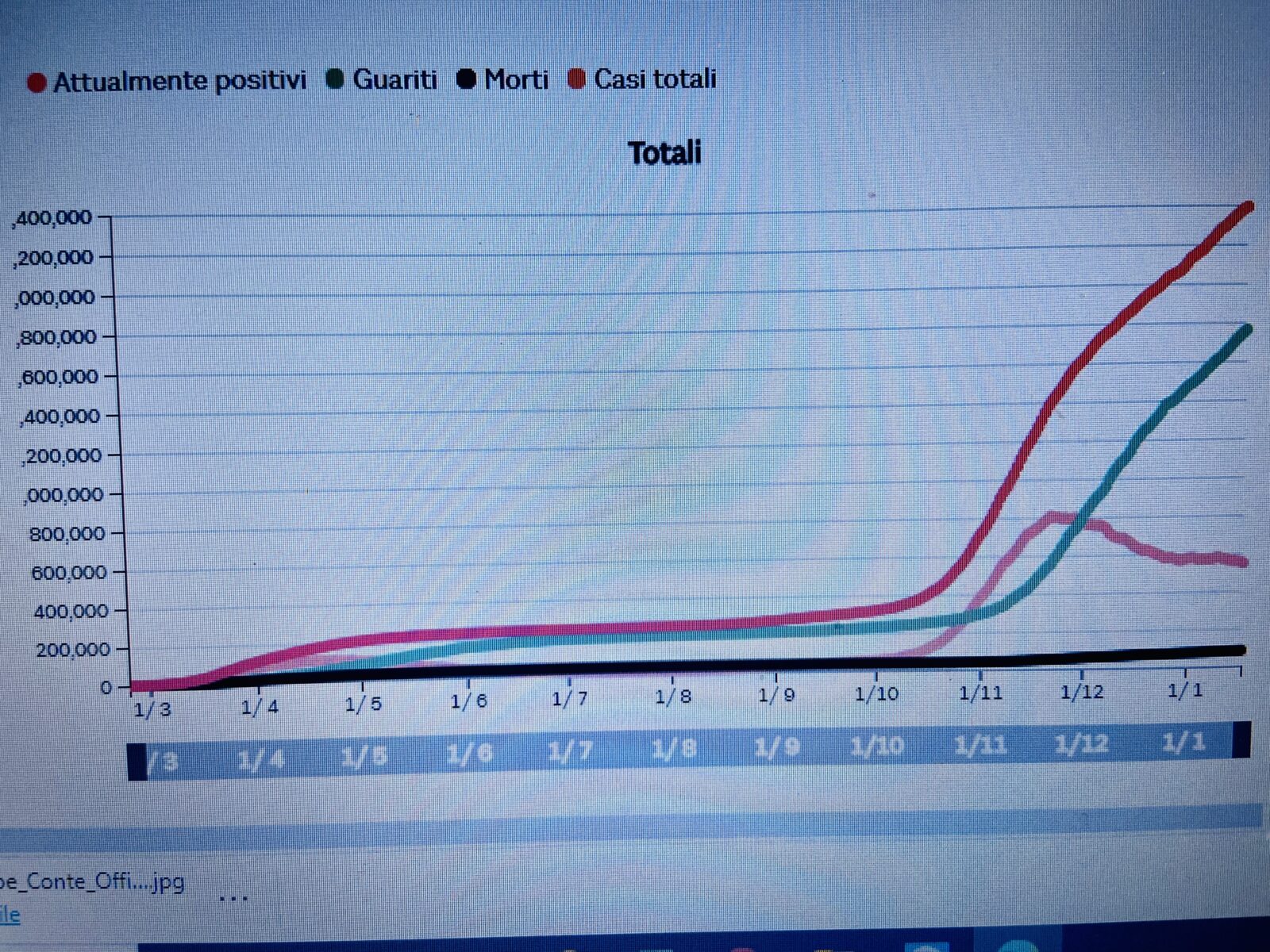Covid Italy 2021: Tougher restrictions until March 5 means my life is in quasi lockdown as government nears collapse

Anyone got a good recipe?
Something simple? Something different? I’m going to be homebound a while.
No, I don’t have Covid. I’m not in quarantine. But I’m retired in Italy where our latest Covid numbers pushed the cautious government to up my Lazio region’s restrictions Sunday from yellow to orange. It’s the second highest in Italy’s color-tier system in which regions change colors nearly as fast as street lights.
Italy is the world pandemic’s intersection of suffering.
Nearly one year after being the first western nation to get slammed by the coronavirus, Italy is again fighting its way out of an economic and public health hole. This time the government is reverting back to its spring stance when near draconian measures of a three-month lockdown almost flattened the curve over the summer.
This latest mandate in Covid Italy 2021 is almost as long. These restrictions go until March 5. Until then, in orange Lazio:
- All restaurants and bars are closed except for takeout and delivery, and bars who don’t serve food can’t even serve drinks to go.
- Gyms and cinemas remain closed.
- No travel between regions except for “essential reasons” such as health or work.
- No more than two guests in your home.
Add these to the national curfew from 10 p.m.-5 a.m. that has been in place since October and up to 1,000-euro fines for violating the national mask mandate. In other words, my hopes of a transition back to la dolce vita in 2021 are more shredded than the parmesan I’m even sprinkling on cereal these days.
I no longer take my good health for granted, not in a country with the fourth-highest Covid death rate in the world. I now have friends who’ve had it. I live near the hospital that administered Italy’s first vaccines and now there’s worry that there won’t be enough medical personnel to administer the vaccines.
Oh, and did I tell you the government is on the verge of collapse?
My Covid life in Italy
Considering people are still hooked up to tubes around here, I won’t complain about my lack of cooking skill. But I live in Rome. Going out to eat is as part of the Roman culture as going out to see the sun. I grew up in an American family that went out to eat, during my 18 years at home, maybe five times. My mom cooked 365 days a year and hoarded canned vegetables as if fearing a nuclear war.
Now I live in the city with the best restaurants in the world, and I’m stuck Googling different ways to eat a basil plant. On Saturday, I spent my last day I could eat out for two months by going to my little corner bar, Caffe Camerino, where the rigatoni with tomato sauce and black olives nearly made me weep. I paid 5 euros.
The new restrictions also confirm that I will go at least 13 months without ever leaving Italy. The restrictions don’t cover travel around the European Union but outside the EU is restrictive and I’m not crazy about risking infection in a world still reeling from this second wave. (The U.S. is still suffering through its first wave, but that’s another story.)
I haven’t left Italy since 12 days in Saudi Arabia in February. I went to the Alban Hills town of Castel Gandolfo last month for lunch and I felt like Ferdinand Magellan crossing the Atlantic.
Yet I’m lucky. I haven’t had a single symptom. Well, two months ago I thought I had joined the other 2.4 million in Italy who contracted Covid. I had a splitting headache for three days. My blood pressure spiked to 143/100. For the first time, I was sincerely worried.
But then Donald Trump lost the election and I was fine.
The Covid Italy 2021 numbers

The rest of Italy isn’t going so well. While it hasn’t reached the catastrophic levels of the U.S., where 4 percent of the world’s population has a quarter of the world’s number of cases and 20 percent of the deaths, Italy’s numbers this winter remain alarming. (For perspective, I added the U.S. numbers. Keep in mind the U.S. has five times the population.):
- Italy’s deaths per 1 million population, accented heavily from the first wave in spring and an older population, is at 1,367, fourth in the world, with Belgium leading at 1,759. (The U.S. is ninth at a close 1,231).
- Italy’s seven-day average of new cases this past week is 14,440 (U.S. is at 220,951), compared to its high of 34,775 on Nov. 15 (the U.S.’ high was 254,161 last Tuesday) and 776 on Aug. 23 (the U.S. averaged 44,055 after that day).
- Italy’s seven-day average of deaths this past week is 479 (the U.S. averages 3,326, and Sunday’s 3,416 was a new high), compared to its all-time high of 741 on Dec. 3 and five on Aug. 23 (the U.S. averaged 997 after that day).
- Italy’s actual positives (new cases minus recovered and deaths) is at 547,058 and dropping (the U.S. is at 9,666,132, a new high) compared to its high of 805,944 on Nov. 22 and 12,076 on July 30 (the U.S. had 2,236,202 that day).
No, we’re not as bad as the tire fire across the pond but it’s enough to alarm a government that, unlike some, actually cares if its people die or not. And it’s doing something about it.
“After Great Britain, Ireland and Germany, a new surge is also coming to us,” prime minister Giuseppe Conte told Italian TV station Tg3 last week. “It will not be easy. We still have to make some sacrifices.”
Added health minister Roberto Speranza: “The epidemiological situation is not to be underestimated. The epidemic is still very strong, and for this reason we still need restrictions and correct behavior.”
Italy’s economy is, like many others, a mess. Its economic relief measures last year increased its public debt by 100 billion euros. The unemployment went from 7.4 percent in April to 9.7 percent by year’s end and forecasts are for it to reach 11.6 percent sometime this year.
To combat it, the government announced a 5.4 billion euro package to help the most devastated sectors such as entertainment, bars and restaurants. Soon Italy should get 222 billion from the European Union’s economic recovery refund fund.
But there may not be a government to help anyone.
On thin ice
Conte, the prime minister, was the new shining star in Italy’s bleak political theater. It has been filled with crooks, racists, shysters and creeps. Then at last comes along this modest, soft-spoken former law professor who served as a compromise candidate in 2018 while the ruling right-wing parties argued over their coalition.
All Conte did was recover from some early mistakes by locking down the country and nearly flatten Italy’s curve by the summer. I and most of Italy loved the guy. In every restaurant I ate in Centro Storico once things reopened, my friends and I toasted to the man saving my beloved adopted country from his office just a few palaces away.

Then, as predicted, the second wave hit after Italians returned from August vacations but nothing hit Conte as hard as one Matteo Renzi. He’s going after Conte like a striker attacking a fourth-division goalkeeper. Renzi has blasted Conte for his handling of the pandemic and is setting up for a major power struggle this week.
Some background: Renzi was Italy’s prime minister from 2014-17 until resigning when his constitutional referendum failed. In September 2019 he formed a small but well-position Italia Viva party. He forced two of his ministers to resign, essentially pulling party support from Conte.
Conte appealed for support from the lower house of the Parliament Monday and will meet the Senate today. Two votes, basically a vote of confidence, will be held and if he doesn’t receive enough, Conte could resign.
In the Italian political scene, this is daily business as usual. Since World War II, Italy has had 66 governments. But none of those changes occurred during a pandemic in which hospitals are filling with patients hoping a vaccine arrives before death does.
Vaccines have arrived
There is good news. Italy vaccinated 500,000 people in the first 13 days of distribution and another 500,000 in the next six days. They’re expecting another 500,000 by today. We have a five-tier priority list for vaccinations: 1. Doctors, health care workers and rest home residents; 2. 80 years old and up; 3. 60-79; 4. Key workers such as teachers and police; 5. General population.
They’re expecting 1,500 vaccination stations where we can get vaccinated free (but not mandatory). I’m in the third category and hope to get vaccinated sometime this spring. Reuters reported that the government hopes those eligible in this nation of 63 million will be vaccinated by September.
Meanwhile, I’m keeping my airline vouchers of flights to Spain, Germany and Greece that were cancelled last year and buying home workout apps off the Internet. Like an Italian mother-in-law, Covid is sticking around for the long haul.
But unlike an Italian mother-in-law, Covid can’t cook.


January 19, 2021 @ 1:32 pm
Thanks John. Love your updates. Looks like my daughter Lisa won’t be coming back to Italy anytime soon, but luckily she got her MFA degree and will come when everyone is vaccinated. Hope you get yours soon. Ours are in process here.
January 19, 2021 @ 5:58 pm
2020’s plan for 2 weeks in Rome went down the tubes, obviously. Is it unreasonable for me to hope for this fall — maybe October or November? Looking for any and all prognostications I can get…
January 19, 2021 @ 6:02 pm
Dreary sad news but good reporting. Thanks John
February 8, 2021 @ 1:40 pm
Thanks for the updates and also offering insight into the workings of the Italian government. I often dream of retiring in Italy (my best friend -also American – has lived in Rome for 20 years) especially given the political situation here. Though my candidate won, I’m afraid Trumpism is here to stay.
The way that we’ve approached COVID here in the U.S. is as you put it a “tire fire” and that’s being kind. I’m praying for quicker vaccination rollout for the entire world and looking forward to visiting your beautiful adopted country next year. In the meantime, I’ll be studying my Italian. Be well!